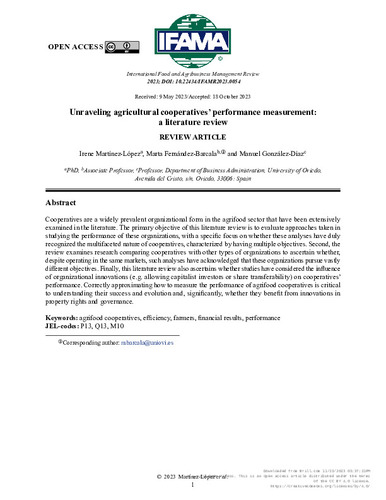Unraveling agricultural cooperatives’ performance measurement: a literature review
Autor(es) y otros:
Palabra(s) clave:
Agrifood cooperatives
Efficiency
Farmers
Financial results
Performance
Fecha de publicación:
Editorial:
Wageningen Academic
Versión del editor:
Citación:
Resumen:
Cooperatives are a widely prevalent organizational form in the agrifood sector that have been extensively examined in the literature. The primary objective of this literature review is to evaluate approaches taken in studying the performance of these organizations, with a specific focus on whether these analyses have duly recognized the multifaceted nature of cooperatives, characterized by having multiple objectives. Second, the review examines research comparing cooperatives with other types of organizations to ascertain whether, despite operating in the same markets, such analyses have acknowledged that these organizations pursue vastly different objectives. Finally, this literature review also ascertains whether studies have considered the influence of organizational innovations (e.g. allowing capitalist investors or share transferability) on cooperatives’ performance. Correctly approximating how to measure the performance of agrifood cooperatives is critical to understanding their success and evolution and, significantly, whether they benefit from innovations in property rights and governance.
Cooperatives are a widely prevalent organizational form in the agrifood sector that have been extensively examined in the literature. The primary objective of this literature review is to evaluate approaches taken in studying the performance of these organizations, with a specific focus on whether these analyses have duly recognized the multifaceted nature of cooperatives, characterized by having multiple objectives. Second, the review examines research comparing cooperatives with other types of organizations to ascertain whether, despite operating in the same markets, such analyses have acknowledged that these organizations pursue vastly different objectives. Finally, this literature review also ascertains whether studies have considered the influence of organizational innovations (e.g. allowing capitalist investors or share transferability) on cooperatives’ performance. Correctly approximating how to measure the performance of agrifood cooperatives is critical to understanding their success and evolution and, significantly, whether they benefit from innovations in property rights and governance.
ISSN:
Patrocinado por:
The authors disclose the receipt of the following financial support for the research, authorship, and/or publication of this article: this project has received funding from the Partnership for Research and Innovation in the Mediterranean Area Programme (PRIMA) as part of the European Union’s PRIMA programme for research and innovation in the Mediterranean area. Particularly, the University of Oviedo also thanks the State Investigation Agency of the Spanish Ministry of Science and Innovation for the funding provided through the PCI2021-121942/AEI/10.13039/501100011033 Project.
Colecciones
- Administración de Empresas [512]
- Artículos [37532]
- Investigaciones y Documentos OpenAIRE [8365]
Ficheros en el ítem





